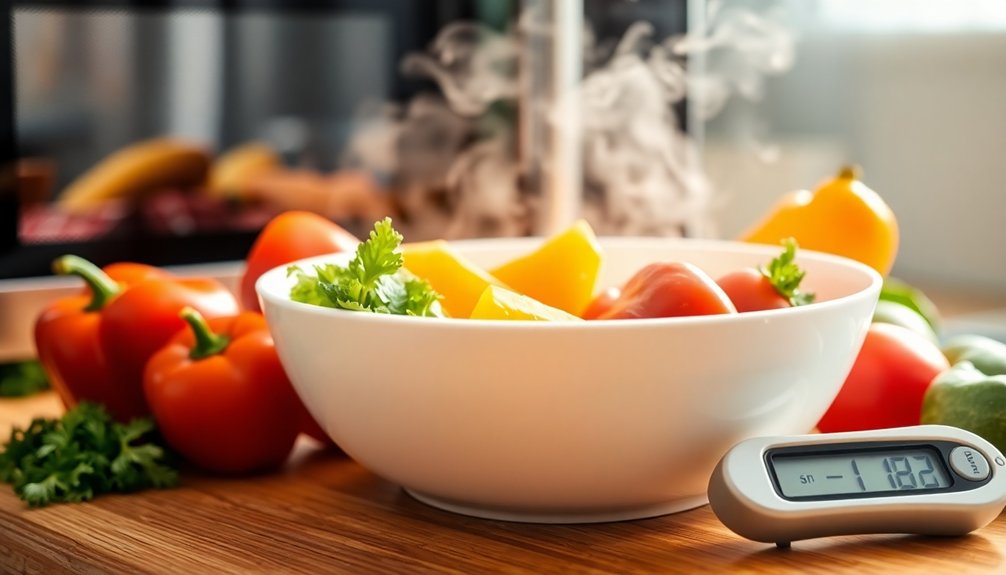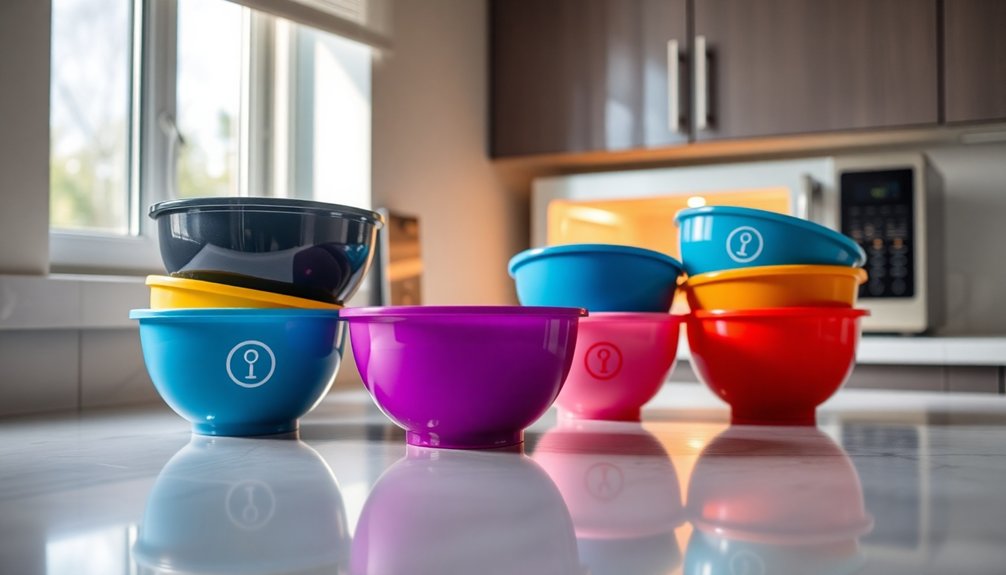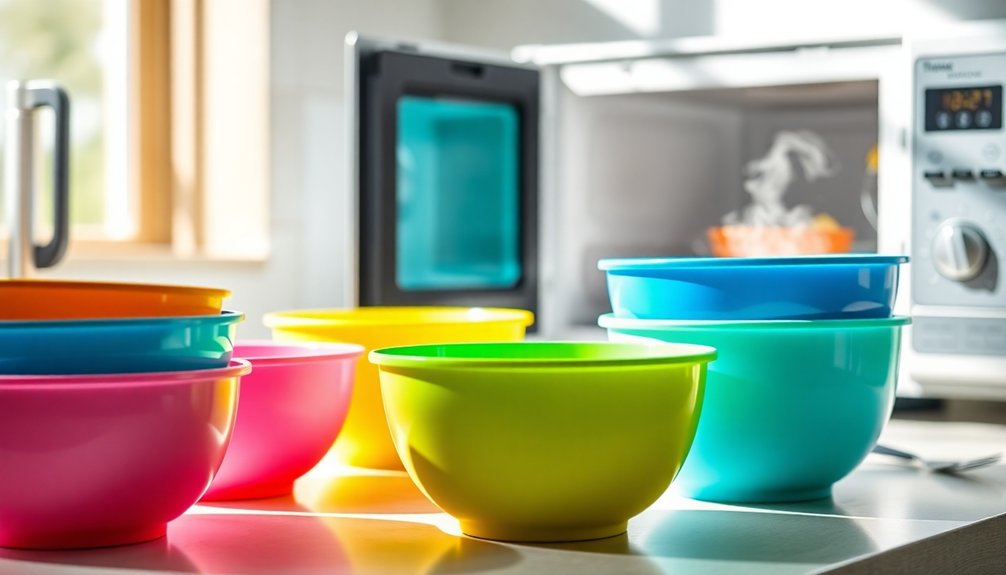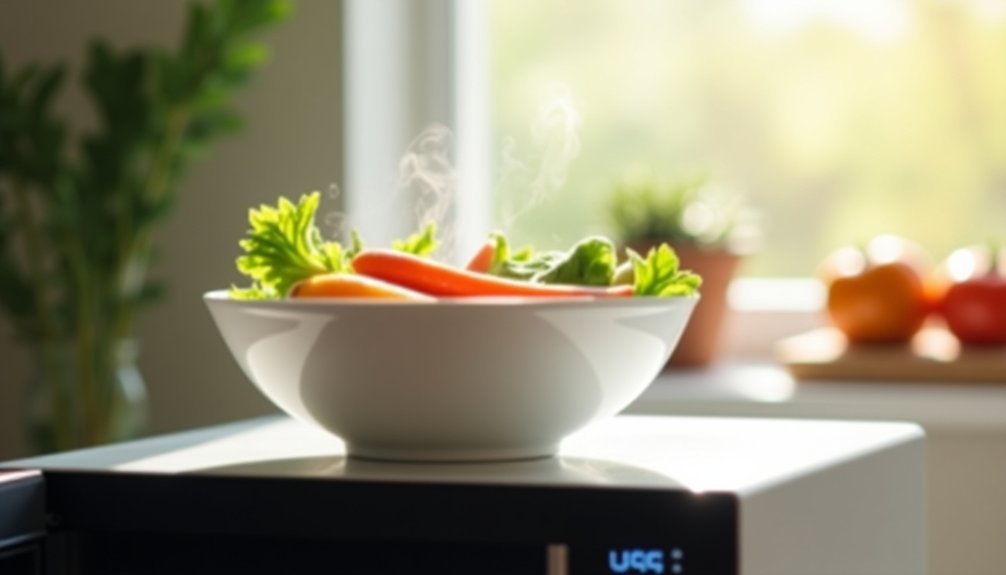Yes, polypropylene bowls are safe for microwave use if you follow specific guidelines. They can withstand temperatures up to 230°F (110°C), making them suitable for reheating most foods. However, stay cautious with high-fat foods, as they may create hot spots that could compromise the bowl's integrity. Always check for a "Microwave Safe" label to ensure FDA compliance. It's wise to conduct a water test to assess heat tolerance. If you're concerned about harmful chemicals, consider using glass or ceramic alternatives. There's more you should know about proper usage and safety precautions for your kitchen, so keep exploring your options!
Key Takeaways
- Polypropylene bowls are FDA-approved for food contact, ensuring they meet safety standards for consumer use.
- They can withstand microwave temperatures up to 230°F (110°C), making them suitable for reheating food.
- Always check for a "Microwave Safe" label to confirm compliance and safety during use.
- High-fat foods may create hot spots, so thicker polypropylene items are recommended for better heat resistance.
- Inspect bowls for cracks or damage, as compromised integrity can pose safety risks when microwaving.
Chemical Structure of Polypropylene
When you look at the chemical structure of polypropylene, you'll find it's primarily composed of propylene monomer units, represented by the formula (C3H6)n. This structure is formed through a process called chain-growth polymerization, where the repeating propylene units create a linear polymer chain made up of carbon and hydrogen atoms. Polypropylene is a thermoplastic polymer that shares characteristics with polyolefins but has unique mechanical properties.
The systematic arrangement of these chains gives polypropylene its thermoplastic properties, meaning it can be melted and reshaped without losing its essential qualities. The foundation of the polymer consists mainly of carbon atoms, with hydrogen atoms filling the remaining valences. In some forms, polypropylene exhibits a predominantly isotactic crystal structure, contributing to its strength and stability. Its excellent impact resistance allows it to absorb energy without breaking, making it suitable for heavy loads and applications requiring high tensile strength.
You'll notice that its density ranges from 0.89 to 0.92 grams per cubic centimeter, which is relatively light compared to other plastics. Additionally, polypropylene demonstrates good chemical resistance to solvents, acids, and alkalis, making it suitable for various applications. Its low water absorption means it's hydrophobic, and while it's stable under normal conditions, be aware that it can melt or deform at high temperatures. This unique combination of properties, including its high melting point, is why polypropylene bowls can be safely used in microwave ovens.
Heat Resistance Properties
Polypropylene's unique chemical structure contributes significantly to its heat resistance properties, making it a popular choice for various applications. Its melting point ranges from 130°C to 171°C (266°F to 340°F), depending on the grade and molecular weight distribution. However, even microwave-safe plastics can leach chemicals when heated, emphasizing the need for caution when using polypropylene bowls in a microwave.
Higher-grade polypropylene typically has better heat resistance, allowing it to withstand elevated temperatures without deforming. Thickness also plays a role; thicker items can handle more heat than thinner ones. Additives, such as heat stabilizers, can further enhance polypropylene's thermal properties.
Practical applications include food packaging, where polypropylene containers endure hot filling and microwave heating. They can hold up to 230°F under heat lamps or microwaves, highlighting their thermal stability. For example, the Incredi-Bowls M7220N are designed to be microwavable and suitable for hot food applications, making them a great choice for convenience.
While polypropylene is generally safe, it's crucial to adhere to temperature limits. The maximum recommended operating temperature is 180°F (82.2°C). Exceeding this can lead to deformation or stress cracking.
Regularly inspecting your polypropylene items for wear, warping, or discoloration helps ensure they remain safe for use. Always follow manufacturer guidelines to guarantee the best performance and safety of your polypropylene bowls.
FDA Regulations Overview

The FDA plays a crucial role in ensuring the safety of food contact substances, which include materials like polypropylene bowls. These substances are defined as any material intended for use in manufacturing, packing, or holding food without having a technical effect on it.
The FDA requires that food contact substances undergo a pre-market review and be authorized before they can be marketed in the U.S. This involves a rigorous scientific safety assessment, which includes analyzing migration and toxicological data to ensure consumer safety. Moreover, migration testing is a critical component of this assessment to evaluate potential transfer of substances to food. Notably, using plastics labeled with recycling codes 1, 2, and 5, which are generally considered microwave safe, is also essential for food safety.
Polypropylene is FDA-approved for food contact, meaning it's deemed safe for use in food applications, including microwaving. The FDA maintains a public inventory of authorized substances, and compliance is essential.
Materials must be made from approved raw materials, and there are specific migration limits that quantify how much of a substance can migrate into food.
In some cases, substances can be exempt from regulations if they create a physical barrier preventing migration. Understanding these regulations helps you make informed choices about the safety of the products you use, including polypropylene bowls, ensuring they meet FDA standards for food safety.
Safety Precautions for Microwaving
When you're microwaving, choosing the right container is crucial for safety. Make sure your bowls are free from harmful additives and can handle the heat without warping or melting. Always monitor the temperature limits to prevent any mishaps while cooking. Additionally, it's essential to check for microwave-safe symbols or resin identification codes on containers, including safe plastics like #2 (HDPE), #4 (LDPE), and #5 (Polypropylene). Always monitor the temperature limits to prevent any mishaps while cooking. Additionally, it's important to avoid placing sealed containers in the microwave to prevent dangerous explosions.
Proper Container Selection
Selecting the right container for microwaving is crucial to ensure both safety and food quality. Always check for microwave-safe labels or symbols on your containers. If there's no indication, refer to the manufacturer's instructions for guidance.
For optimal safety, use materials like polypropylene (PP), polycarbonate (PC), ceramic, silicone, or glass, as these are generally safe for microwaving. To test a container's safety, place it in the microwave alongside a microwave-safe cup of water. If the container remains cool while the water heats up, it's likely safe to use. Be mindful of temperature ratings; containers should withstand high temperatures above 212°F (100°C).
Avoid using metal, as it can spark and damage your microwave. Styrofoam and certain paper products may melt or release harmful substances, so steer clear unless they're explicitly labeled as microwave-safe. Additionally, never use travel mugs with vacuum seals, as they can explode due to pressure build-up. Lastly, remember to leave a vent for steam in sealed containers to prevent pressure from building up. It's important to familiarize yourself with common safe materials to ensure you are using appropriate containers for your microwaving needs.
Avoiding Harmful Additives
Understanding the potential risks associated with additives in microwave-safe containers is key to ensuring your food stays safe during reheating. When you choose polypropylene (PP) bowls, be aware that fillers and colorants may not be transparent to microwaves, which can compromise safety.
The FDA regulates the materials used in food containers, so look for products that comply with these regulations and are labeled as microwave-safe.
Check for manufacturer's guidelines that outline proper microwave use, as some plastics may contain harmful chemicals like BPA or phthalates that can leach into your food when heated. Ensure that the materials in your container demonstrate chemical resistance at the temperatures you'll be using. Microwave-safe plastics should undergo rigorous testing to ensure they do not leach harmful chemicals when heated.
It's also crucial to confirm that any additives are compatible with microwave heating to avoid health risks.
To minimize concerns, consider using alternatives like glass or ceramic, which typically don't have these issues.
Always prioritize containers that display specific symbols indicating microwave safety, such as the wavy lines symbol. By being vigilant about these factors, you can make informed decisions and keep your meals safe during reheating.
Monitoring Temperature Limits
Monitoring temperature limits is essential for ensuring the safety of your food when using polypropylene bowls in the microwave. These bowls can withstand temperatures up to about 230°F (110°C) without deforming or melting.
However, be mindful of the content you're heating. High-fat foods can create hot spots that may lead to heat distortion, compromising the bowl's integrity.
Before microwaving, always check the label for "Microwave Safe" or the microwave symbol. This guarantees that the bowl meets FDA safety standards and can handle the heat. Additionally, it is important to remember that certain plastics designed for cold storage are not suitable for reheating in the microwave.
Consider the container's thickness; thicker bowls often provide better heat resistance. Residual stresses from manufacturing can also impact how well the bowl performs under heat.
It's worth noting that additives or colorants in the polypropylene can affect its microwave safety, so ensure you're using a quality product.
If you're ever uncertain, conduct a simple water test by placing a microwave-safe glass cup filled with water inside alongside the polypropylene bowl. This way, you can gauge how well the bowl handles heat in comparison.
Identifying Safe Symbols

When choosing polypropylene bowls for microwave use, it's crucial to look for specific symbols and labels that indicate safety. First and foremost, check for a "Microwave Safe" label; this is your green light for microwave use. You might also find an imprinted microwave symbol, especially on reusable plastic storage containers, which indicates they're microwave-friendly.
Additionally, always refer to the manufacturer's instructions on other plastic containers or wraps, as they can provide essential guidance for safe microwave use. Remember, all plastic food packaging must comply with strict FDA safety standards, ensuring that products are safe for food contact.
It's essential to be aware of the materials used. Polypropylene (PP) is designed to withstand microwave heat, while polyethylene (PE) is generally safe too. However, avoid using polystyrene (PS), as it can release harmful chemicals when heated.
Lastly, inspect your bowls for any damage. Cracks or signs of wear can compromise safety. Keep an eye out for these symbols and labels to ensure your polypropylene bowls are safe for microwave use!
When shopping for polypropylene bowls, opt for those made from recycling code #5 PP as they are generally considered safe for microwave use.
Tips for Reheating Food
Reheating food safely requires attention to temperature and the right containers. To ensure your leftovers are safe to eat, start by reheating them to a minimum temperature of 165°F. Keep your food out of the danger zone (40°F to 140°F) to prevent bacteria from growing. Always use a food thermometer to confirm that the reheated food reaches the proper temperature quickly—ideally, within 2 hours. When reheating in polypropylene containers, be aware that the FDA recommends storing food at temperatures up to 120C (248F) and allow hot food to cool slightly before placing it in these containers to minimize the risk of chemical leaching.
| Tip | Details | Importance |
|---|---|---|
| Cover Leftovers | Keep moisture in for even heating | Prevents drying out |
| Monitor Temperature | Check regularly during reheating | Ensures food reaches 165°F |
| Use Short Intervals | Heat in small bursts | Prevents overcooking |
| Reheat Sauces to Boil | Bring to a rolling boil | Ensures safety |
| Avoid Overloading | Reheat in batches if needed | Promotes even heating |
Choosing the Right Containers

Choosing the right containers for reheating food can significantly impact both safety and quality. When you're selecting containers, focus on materials that are microwave-safe and have the proper labeling.
- Check for Symbols: Look for the microwave-safe symbol or a #5 recycling code, indicating polypropylene, which is generally safe for microwave use.
- Avoid Certain Plastics: Steer clear of APET(E) and PS containers, as these can melt or leach harmful chemicals when heated.
- Consider Eco-Friendly Options: If you're leaning towards sustainability, polypropylene is recyclable, while palm leaf bowls are a great alternative that can handle high temperatures.
- Polypropylene has a high melting point (approximately 160°C/320°F), making it well-suited for reheating purposes.
Always verify manufacturer labels and product specifications to ensure safety.
Remember, the suitability of a container also depends on its heat resistance. Polypropylene can handle temperatures up to 230°F, but be cautious with additives and colorants that may affect microwave safety.
Frequently Asked Questions
Can Polypropylene Bowls Leach Chemicals Into Food?
You don't need to worry about polypropylene bowls leaching chemicals into food. They're generally considered safe, especially those explicitly labeled as "Microwave Safe" and free from harmful substances like PFAS. Always check product labeling.
How Long Can Polypropylene Bowls Last in the Microwave?
Polypropylene bowls can last in the microwave for several years if used properly. Just avoid prolonged high temperatures and check for any damage. Always look for microwave-safe labels to ensure safe use during reheating.
Are There Any Health Risks With Repeated Use?
Using polypropylene bowls repeatedly can pose health risks. They might leach harmful chemicals when heated, leading to potential hormonal issues and other health concerns. It's wise to be cautious and consider alternatives for long-term use.
Can I Use Polypropylene Bowls for Freezing Food?
Yes, you can use polypropylene bowls for freezing food. They're generally safe and resistant to low temperatures, but always check for freezer-specific labeling to avoid brittleness and potential cracking during freezing.
Are Colored Polypropylene Bowls Safe for Microwaving?
When using colored polypropylene bowls in the microwave, you should check for microwave-safe symbols and manufacturer guidelines. Ensure they're designed for heat resistance to avoid risks like distortion or chemical leaching during use.

